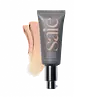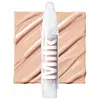What's inside
What's inside
 Key Ingredients
Key Ingredients

 Benefits
Benefits

 Concerns
Concerns

 Ingredients Side-by-side
Ingredients Side-by-side

Zinc Oxide 15%
Cosmetic ColorantWater
Skin ConditioningCoco-Caprylate/Caprate
EmollientVitis Vinifera Seed Oil
EmollientC15-19 Alkane
SolventIsocetyl Stearoyl Stearate
EmollientArgania Spinosa Kernel Oil
EmollientTocopheryl Acetate
AntioxidantSodium Hyaluronate Crosspolymer
HumectantJojoba Esters
EmollientTribehenin
EmollientBeeswax
Emulsion StabilisingGlyceryl Stearate
EmollientLeuconostoc/Radish Root Ferment Filtrate
AntimicrobialGlycerin
HumectantLactobacillus
Skin ConditioningAcacia Senegal Gum
MaskingXanthan Gum
EmulsifyingViola Tricolor Extract
EmollientBisabolol
MaskingGlycyrrhiza Glabra Root Extract
BleachingSodium Hyaluronate
HumectantAloe Barbadensis Leaf Extract
EmollientCocos Nucifera Fruit Extract
EmollientTitanium Dioxide
Cosmetic ColorantIron Oxides
Mica
Cosmetic ColorantZinc Oxide 15%, Water, Coco-Caprylate/Caprate, Vitis Vinifera Seed Oil, C15-19 Alkane, Isocetyl Stearoyl Stearate, Argania Spinosa Kernel Oil, Tocopheryl Acetate, Sodium Hyaluronate Crosspolymer, Jojoba Esters, Tribehenin, Beeswax, Glyceryl Stearate, Leuconostoc/Radish Root Ferment Filtrate, Glycerin, Lactobacillus, Acacia Senegal Gum, Xanthan Gum, Viola Tricolor Extract, Bisabolol, Glycyrrhiza Glabra Root Extract, Sodium Hyaluronate, Aloe Barbadensis Leaf Extract, Cocos Nucifera Fruit Extract, Titanium Dioxide, Iron Oxides, Mica
Homosalate 5%
Skin ConditioningEthylhexyl Salicylate 4.5%
UV AbsorberOctocrylene 5%
UV AbsorberTitanium Dioxide 2.9%
Cosmetic ColorantZinc Oxide 5.1%
Cosmetic ColorantWater
Skin ConditioningButylene Glycol
HumectantCrambe Abyssinica Seed Oil Phytosterol Esters
EmulsifyingCaprylic/Capric Triglyceride
MaskingSqualane
EmollientGlyceryl Oleate
EmollientPolyglyceryl-3 Polyricinoleate
EmulsifyingPentylene Glycol
Skin ConditioningSilica
AbrasiveDiisostearyl Malate
EmollientSodium Chloride
MaskingStearalkonium Hectorite
Gel FormingSimmondsia Chinensis Seed Oil
EmollientOlea Europaea Fruit Oil
MaskingPersea Gratissima Oil
Skin ConditioningVitis Vinifera Seed Oil
EmollientCitrus Nobilis Peel Oil
MaskingTremella Fuciformis Sporocarp Extract
AntioxidantLonicera Japonica Flower Extract
Skin ConditioningTocopheryl Acetate
AntioxidantTribehenin
EmollientMagnesium Aluminum Silicate
AbsorbentIsostearic Acid
CleansingLecithin
EmollientPolyhydroxystearic Acid
EmulsifyingHydrogenated Olive Oil Unsaponifiables
EmollientAlumina
AbrasiveStearic Acid
CleansingJojoba Esters
EmollientGlycerin
HumectantOlea Europaea Oil Unsaponifiables
Skin ConditioningAcacia Senegal Gum
MaskingEthylhexylglycerin
Skin ConditioningXanthan Gum
EmulsifyingBetaine
HumectantPotassium Sorbate
PreservativePhenoxyethanol
PreservativeParfum
MaskingIron Oxides
Homosalate 5%, Ethylhexyl Salicylate 4.5%, Octocrylene 5%, Titanium Dioxide 2.9%, Zinc Oxide 5.1%, Water, Butylene Glycol, Crambe Abyssinica Seed Oil Phytosterol Esters, Caprylic/Capric Triglyceride, Squalane, Glyceryl Oleate, Polyglyceryl-3 Polyricinoleate, Pentylene Glycol, Silica, Diisostearyl Malate, Sodium Chloride, Stearalkonium Hectorite, Simmondsia Chinensis Seed Oil, Olea Europaea Fruit Oil, Persea Gratissima Oil, Vitis Vinifera Seed Oil, Citrus Nobilis Peel Oil, Tremella Fuciformis Sporocarp Extract, Lonicera Japonica Flower Extract, Tocopheryl Acetate, Tribehenin, Magnesium Aluminum Silicate, Isostearic Acid, Lecithin, Polyhydroxystearic Acid, Hydrogenated Olive Oil Unsaponifiables, Alumina, Stearic Acid, Jojoba Esters, Glycerin, Olea Europaea Oil Unsaponifiables, Acacia Senegal Gum, Ethylhexylglycerin, Xanthan Gum, Betaine, Potassium Sorbate, Phenoxyethanol, Parfum, Iron Oxides
 Reviews
Reviews

Alternatives
Ingredients Explained
These ingredients are found in both products.
Ingredients higher up in an ingredient list are typically present in a larger amount.
Acacia Senegal Gum has skin soothing, thickening, and formulation stabilizing properties. It comes from the Acacia tree that is native to sub-Saharan Africa.
Glycerin is already naturally found in your skin. It helps moisturize and protect your skin.
A study from 2016 found glycerin to be more effective as a humectant than AHAs and hyaluronic acid.
As a humectant, it helps the skin stay hydrated by pulling moisture to your skin. The low molecular weight of glycerin allows it to pull moisture into the deeper layers of your skin.
Hydrated skin improves your skin barrier; Your skin barrier helps protect against irritants and bacteria.
Glycerin has also been found to have antimicrobial and antiviral properties. Due to these properties, glycerin is often used in wound and burn treatments.
In cosmetics, glycerin is usually derived from plants such as soybean or palm. However, it can also be sourced from animals, such as tallow or animal fat.
This ingredient is organic, colorless, odorless, and non-toxic.
Glycerin is the name for this ingredient in American English. British English uses Glycerol/Glycerine.
Learn more about GlycerinJojoba Esters is a wax created from Jojoba oil. It is an emollient and film-forming ingredient. In bead form, it is an exfoliator.
This ingredient has high oxidative stability, meaning it doesn't break down when exposed to oxygen.
Its similarity to our skin's natural oils makes it a great emollient. Emollients help soften and soothe our skin by creating a barrier on top. This barrier helps trap moisture in, keeping skin hydrated.
It is created using either the hydrogenation or transesterification processes on jojoba oil.
Learn more about Jojoba EstersTitanium dioxide is a mineral UV filter widely used in sunscreens and cosmetics.
It is one of only two UV filters officially classified as “mineral” by regulatory agencies, the other being zinc oxide.
Titanium dioxide provides broad-spectrum protection mostly in the UVB and UVAII range, with some protection in the UVAI range.
While its UVA protection isn’t as strong as zinc oxide’s, the difference is minor.
A common myth is that mineral UV filters reflect UV light. However, modern research shows titanium dioxide absorbs UV radiation like chemical filters (~95% absorption & 5% reflection).
Thanks to its non-irritating nature, titanium dioxide is suitable for sensitive, acne-prone, or redness-prone skin. It is unlikely to cause "eye sting" like other sunscreen ingredients.
A major drawback of this ingredient is its white cast and thick texture. This is why mineral sunscreens often leave a white cast and are less cosmetically elegant than chemical/hybrid sunscreens.
To improve white cast and spreadability, micronized or nano-sized titanium dioxide is often used.
There are ongoing concerns surrounding nano-titanium oxide's impact on marine ecosystems.
There is no conclusive evidence that any form of titanium oxide (or any other sunscreen ingredients) will cause harm to marine ecosystems or coral reefs. The science is still developing but many consumers are keeping a close eye on this issue.
Please note, many destinations have reef-safety sunscreen rules. For instance, the U.S. Virgin Islands advises all visitors to use non-nano mineral sunscreens.
Nano mineral sunscreens once raised safety concerns about absorption into skin.
Extensive research has shown that they do not penetrate healthy or damaged skin; they remain safely on the surface and the top layer of dead skin (stratum corneum).
You'll likely find titanium dioxide bundled with alumina, silica, or dimethicone. These ingredients help make titanium dioxide highly photostable; this prevents it from interacting with other formula components under UV light.
Learn more about Titanium DioxideTocopheryl Acetate is AKA Vitamin E. It is an antioxidant and protects your skin from free radicals. Free radicals damage the skin by breaking down collagen.
One study found using Tocopheryl Acetate with Vitamin C decreased the number of sunburned cells.
Tocopheryl Acetate is commonly found in both skincare and dietary supplements.
Learn more about Tocopheryl AcetateTribehenin comes from glycerin and behenic acid.
It is used as an emollient, or moisturizer. Emollients form a thin barrier on skin to prevent moisture from escaping.
This ingredient may not be Malassezia folliculitis, or fungal-acne safe.
Learn more about TribeheninVitis Vinifera Seed Oil comes from the grape vine. Grape seeds are a byproduct of creating grape juice or wine.
The components of grape seeds have many skin benefits. Research has found it to be antimicrobial and anti-inflammatory. It also contains many potent antioxidants such as Vitamin E , Vitamin C, proanthocyanidins, polyphenols, flavonoids, and anthocyanins. Proanthocyanidin has been shown to help even out skin tone.
Antioxidants help fight free-radical molecules. Free-radical molecules are capable of damaging our cells and other genetic material. Antioxidants help stabilize free-radicals by donating extra electrons. Grape seed extract may help reduce the signs of aging.
The antimicrobial properties of grape seed may help treat acne. However, more research is needed to support this claim.
Grape seed has also been found to help absorb UV rays. Grape seed extract should not replace your sunscreen.
The fatty acids of grape seed oil give it emollient properties. Emollients help soothe and soften your skin by creating a film. This film traps moisture within, keeping your skin hydrated.
Learn more about Vitis Vinifera Seed OilWater. It's the most common cosmetic ingredient of all. You'll usually see it at the top of ingredient lists, meaning that it makes up the largest part of the product.
So why is it so popular? Water most often acts as a solvent - this means that it helps dissolve other ingredients into the formulation.
You'll also recognize water as that liquid we all need to stay alive. If you see this, drink a glass of water. Stay hydrated!
Learn more about WaterXanthan gum is used as a stabilizer and thickener within cosmetic products. It helps give products a sticky, thick feeling - preventing them from being too runny.
On the technical side of things, xanthan gum is a polysaccharide - a combination consisting of multiple sugar molecules bonded together.
Xanthan gum is a pretty common and great ingredient. It is a natural, non-toxic, non-irritating ingredient that is also commonly used in food products.
Learn more about Xanthan GumZinc Oxide is a mineral broad-spectrum UV filter; it is the broadest UVA and UVB reflector approved by the FDA. It also has skin protectant and skin soothing properties.
Zinc oxide is one of the most effective broad-spectrum UV filters. It protects against UVB, UVAII, and UVAI. In comparison to its counterpart titanium dioxide, zinc oxide provides uniform and extended UVA protection.
Another great benefit? This ingredient is highly photostable so it won't degrade easily under sunlight.
A common myth is that mineral UV filters are widely believed to primarily reflect UV light.
However, modern research shows titanium dioxide absorbs UV radiation like chemical filters (~95% absorption & 5% reflection).
Zinc oxide has great skin soothing properties so you'll likely find this in sunscreens formulated for sensitive skin or babies/children. It is unlikely to cause "eye sting" like other sunscreen ingredients.
Regulatory agencies consider zinc oxide to be non-toxic and safe. It has also been shown to not penetrate the skin.
Unfortunately, this ingredient does leave a visible white cast. This is why mineral sunscreens are often less cosmetically elegant than chemical or hybrid ones.
In cosmetics, zinc oxide can be found in both non-nano and nano-sized forms. The nano version is used to reduce white cast and improve the texture of sunscreen formulas.
There are ongoing concerns surrounding nano-zinc oxide's impact on marine ecosystems and whether it can be absorbed into skin.
Regarding marine ecosystems and coral reefs, there is no conclusive evidence that any form of zinc oxide (or any other sunscreen ingredients) will cause harm. The science is still developing but many consumers are keeping a close eye on this issue.
Please note, many destinations have reef-safety sunscreen rules. For instance, the U.S. Virgin Islands advises all visitors to use non-nano mineral sunscreens.
There has also been some stir about whether micronized or nano zinc oxide has potential photoxicity and absorption through the skin/lungs.
An in-vitro (done in a test tube or petri dish) study demonstrated micronized zinc oxide to have potential phototoxicity. There's no need to fret; the EU Commission's Scientific Committee on Consumer Safety has stated, "The relevance of these findings needs to be clarified by appropriate investigations in vivo." Or in other words, further studies done on living organisms are needed to prove this.
Current research shows zinc oxide nanoparticles do not penetrate intact or sunburned skin. They either remain on the surface or in the outermost layer of dead skin (stratum corneum).
Zinc oxide is one of only two classified mineral UV filters with titanium dioxide being the other one.
Fun fact: Zinc has been used throughout history as an ingredient in paint and medicine. An Indian text from 500BC is believed to list zinc oxide as a salve for open wound. The Ancient Greek physician Dioscorides has also mentioned the use of zinc as an ointment in 1AD.
Learn more about Zinc OxideThis ingredient is a combination of red, black, and yellow iron oxide pigments. This combination of colors is usually found in foundation, because it results in a "skin" color.